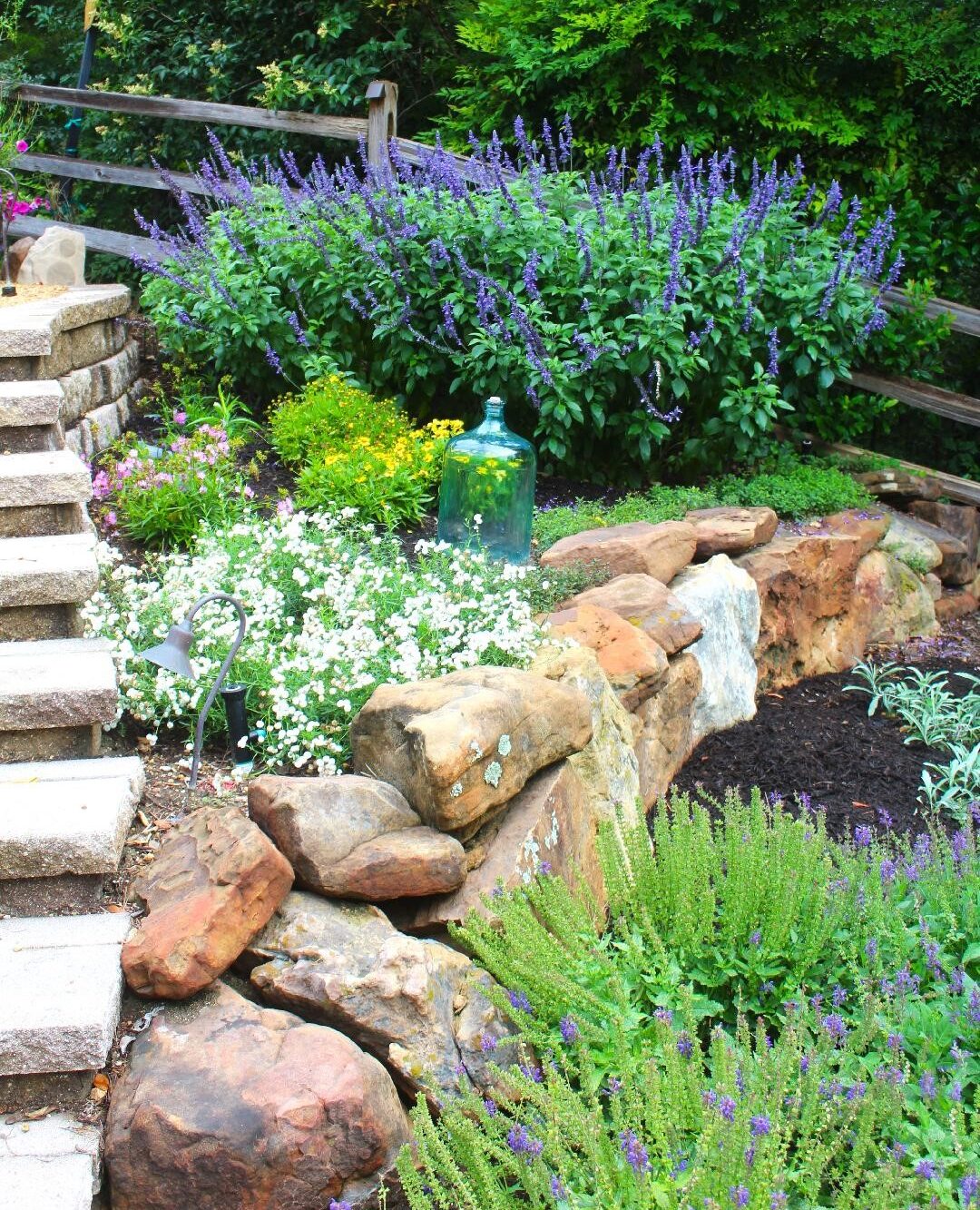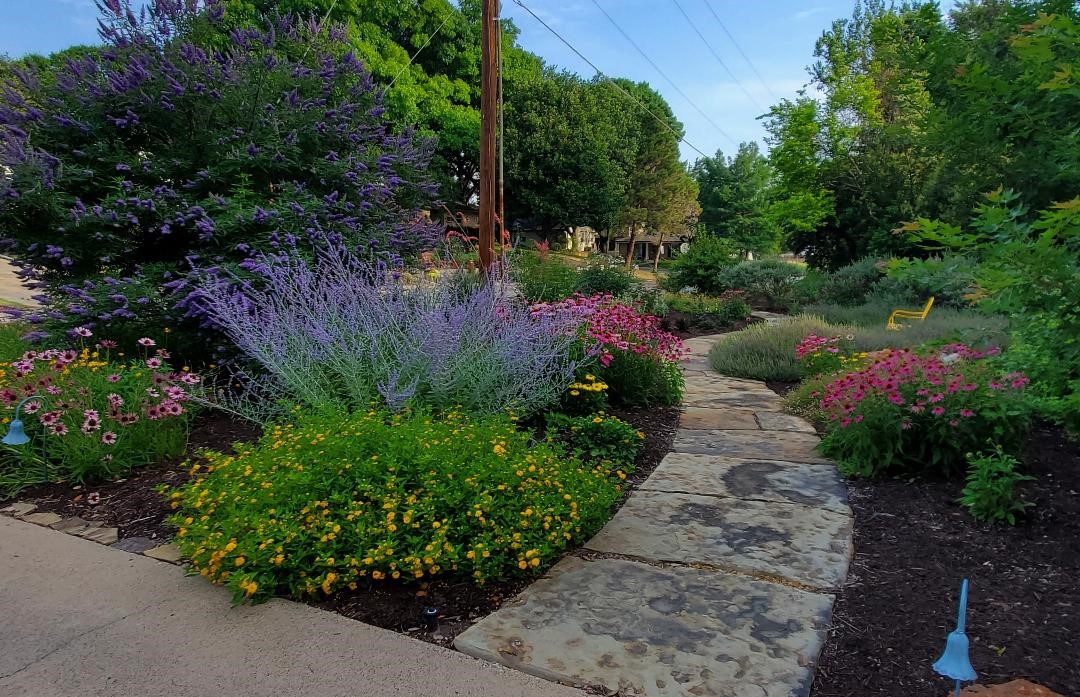May 17, 2024
By Alan Rister
The upcoming DCMGA Garden Tour on May 18 will feature eight beautiful gardens, including the garden of Suzy Renz, as one of the stops on this year’s tour.
Once upon a time, a very conventional house in northeast Dallas had an acre of lawn and very little more than a couple of live oak trees, some unremarkable foundation shrubs, and a tired looking wooden deck in the back to make up what passed for a “yard.” Then along came Suzy Renz, on a house-hunt, who instantly saw the potential for garden greatness at this unique site, and the rest, as they say, has been five-going-on-six years of creating everything you can see at this exceptional property located on Park Branch creek.

Among Dallas Master Gardeners, Suzy is known for her singular originality and creativity in garden and home design as well as her very “green” thumbs. She is known in particular for her “Farmhouse Eclectic” style, influenced by many trips to the Round Top Antiques Fair, where one-of-a-kind objects abound and can become the stars of design vignettes when carted back home. So, unsurprisingly her yard stands out in her neighborhood as a glorious testament to both her distinctive plantswomanship and its marriage to inventive garden design.
At the front of the property the “North Forty” garden, which extends along the street from the driveway to the corner of the block in an ever-narrowing strip, is a fine collection of native and adapted plants that thrive in the full sun exposure. Suzy’s prowess
at choosing the “right plant for the right place” is on full view here, as these sun-hardy specimens—the purple of Coneflowers, the blue of Russian Sage, the azure of Vitex, the yellow of Lantana, the red of Texas Yucca, and so many more—appear completely at home together in this garden space. Large slabs of Oklahoma flagstone form a lazy river pathway that invites strolling and exploring this excellent collection of well chosen plants.
When entering Suzy’s back yard through the custom-made “GARDEN” gate sign, one immediately has the sense of having arrived in a wonderland of personal horticultural and artistic expression, for this is an intensely personal space. The first steps into this special place always evoke a gasp of surprise, because this garden and indeed this house are all about the appreciation of a hidden fifteen-foot deep ravine and the creek that carved it, which are essentially invisible from the street level. A split rail fence of native cedar defines the edge of the wild from the tended garden within and demarcates the fringe of the native woods beyond. The first view of this completely unexpected terrain demands a long pause for wonderment.
Meanwhile, discovery of Suzy’s creative design talents begins with a survey of the top terrace adjoining the back of the house, which she and husband Rob extensively remodeled. Any old galvanized bucket or unusual flower pot can, in Suzy’s hands, become a container for spotlighting annual plantings of various colorful flowers. A whimsical found-object sculpture by local artist Janice Sommerville stands as a sentinel at the back door, part of Suzy’s collection of several pieces by this artist. Other mostly unidentifiable but interesting mechanical objects randomly punctuate the scene here and there. Still other smile-provoking figures, such as the trio of little concrete fisherboys and a welded iron cat whose spine is an old industrial spring, hang out around the swimming pool and exemplify the un-fussiness of this garden.
From the patio just outside the back door a series of switchback steps lead dramatically down the back yard slope to a firepit surrounded by Adirondack chairs in a rainbow of happy colors. Arriving at this convivial destination one has the feeling of having descended into an immersion in green, as the lush foliage of this remarkable site envelops the seating area and indeed the entire back yard.

A blue glass bottle tree nestles among a grove of Abelia ‘Canyon Creek’ on the lower terrace level along with smaller blue bottle “bush.” The Abelias along with a dense planting of Junipers on the middle level function as screens of green to conceal the concrete landscape blocks that form retaining walls. These walls serve primarily to hold the house and garden in their proper places, but they also create dramatic changes of elevation as the back yard drops precipitously towards the creekbed below.
While this garden shows evidence of constant attention and hard work on the horticulture, it also manages to look effortless because of the abundance of fanciful, unpretentious decorative elements. Little wonder, then, that Suzy says what she loves most about her garden is the opportunity for exercising the unlimited “process of creating.” Fortunate is she who has found her Happy Place.
Alan Rister, Dallas County Master Gardener Class of 2005

And fortunate are we, to get to see this garden tomorrow! Tickets for the Dallas County Master Garden Tour are $18.00 until 6pm tonight and $22.00 thereafter.







































